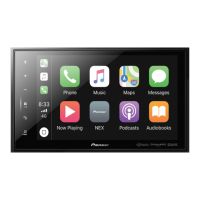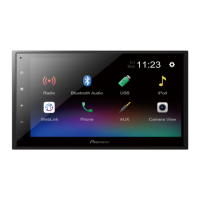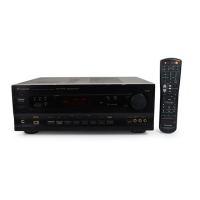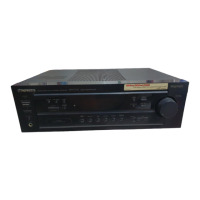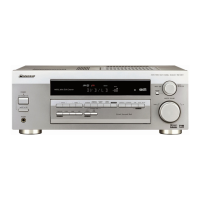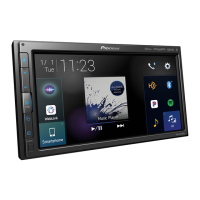
Do you have a question about the Pioneer DMH-C2500NEX and is the answer not in the manual?
| Screen Size | 6.8 inches |
|---|---|
| Bluetooth | Yes |
| Apple CarPlay | Yes |
| Android Auto | Yes |
| Built-in Amplifier | Yes |
| Radio Tuner | AM/FM |
| SiriusXM-Ready | Yes |
| Rear View Camera Input | Yes |
| Navigation | No |
| HD Radio | Yes |
| EQ Settings | 13-Band Graphic Equalizer |
| Steering Wheel Control Compatible | Yes |
| Backup Camera Input | Yes |
| Wireless Connectivity | No |
| USB Ports | 1 |
| Preamp Outputs | 3 (Front, Rear, Subwoofer) |
| RMS Power Output | 14 watts |
| Audio Formats | MP3, WMA, AAC, FLAC |
User information, FCC compliance, and RF exposure guidelines.
Guidelines for safe listening levels to protect hearing and prevent accidents.
General warnings about installation, liquids, fire hazards, and electrical shock.
Identifies buttons and controls on the main unit of the receiver.
Details buttons and functions of the provided remote control.
Steps to reset the unit to factory settings and when to perform it.
Instructions for inserting the battery into the remote control.
How to operate the unit using the remote control.
Initial steps to turn on the unit and select language/speaker settings.
Procedure to change speaker configuration settings.
How to interact with the unit's touchscreen interface.
How to navigate and interact with list-based displays.
How to adjust playback position using the time bar.
How to access and use the menu bar for various functions.
Explains the layout and navigation of the main menu screen.
Steps to establish a Bluetooth connection with a mobile device.
Configuration options for Bluetooth functionality.
How to manage multiple connected Bluetooth devices.
Steps to initiate a phone call via Bluetooth.
How to use saved phone numbers for quick dialing.
How to answer or reject incoming calls.
Using Siri for voice commands with iPhone.
Settings for call handling like auto-answer and ring tone.
Switching call audio to the phone during a conversation.
Adjusting volume for the person on the other end of the call.
General notes and tips for using the hands-free phone feature.
How to connect and play audio via Bluetooth.
Interface and controls for playing audio via Bluetooth.
Lists all available audio and video sources for the unit.
How to access the main screen for managing AV sources.
Steps to choose and activate different AV sources.
How to rearrange source icons on the screen.
How to rearrange source keys on the screen.
Customizing the area for favorite source icons.
Explains what HD Radio stations are and their features.
Steps to activate and begin using the HD Radio function.
How to navigate and use the HD Radio interface.
How to automatically save the best radio stations.
Configuration options for radio tuning and reception.
Procedures for connecting, disconnecting, and operating USB storage devices.
Controls and interface for playing audio files from USB.
How to find and select audio files using Music Browse mode.
Procedures and interfaces for playing video and viewing image files from USB.
Steps to connect an iPod to the unit via USB or Bluetooth.
Controls for navigating and playing iPod content.
Interface for iPod audio playback.
Additional interface elements for iPod audio playback.
Using the Apple Music Radio feature with iPod.
Interface for Apple Music Radio playback.
Overview of how to use smartphone apps via WebLink.
Steps to launch and connect for WebLink.
Mixing audio from AV source and smartphone app.
Overview of how to use iPhone apps via Apple CarPlay.
Adjusting vehicle settings for optimal CarPlay performance.
Steps to connect and start Apple CarPlay.
How to adjust guidance and main volumes for CarPlay.
Overview of how to use Android apps via Android Auto.
Adjusting vehicle settings for optimal Android Auto performance.
Steps to connect and start Android Auto.
How to adjust guidance and main volumes for Android Auto.
Configuring Android Auto to launch automatically.
How to connect and listen to Pandora music.
Controls for playing Pandora music.
Interface and controls for Pandora playback.
How to connect and listen to Spotify music.
Controls for playing Spotify music.
Interface and controls for Spotify track playback.
Additional interface for Spotify track playback.
Interface and controls for Spotify radio mode.
Additional interface for Spotify radio mode.
Steps to activate and subscribe to the SiriusXM service.
How to tune into and listen to SiriusXM channels.
Controls for navigating and selecting SiriusXM channels.
Interface showing current SiriusXM channel information.
Using the replay feature for SiriusXM broadcasts.
Using TuneScan to preview songs on preset channels.
Receiving notifications for sports events.
How preset channels buffer content for features.
Discovering new channels via Featured Favorites.
Setting up parental controls for mature content.
General settings for the SiriusXM service.
Steps to connect and use an AUX audio/video source.
Controls for operating the AUX input.
Interface for controlling the AUX input.
Steps to connect and display video from an AV input or camera.
Overview of accessing vehicle data and OEM systems via iDatalink.
Steps to prepare and activate the iDatalink Maestro adapter.
Steps to connect and enable iDatalink functionality.
How to use iDatalink features related to car sources.
How to use iDatalink features related to car features.
Configuration options for iDatalink functions.
General system configuration, AV sources, and connectivity options.
Customizing visual appearance, screen brightness, and panel calibration.
Adjusting equalizer, speaker levels, fader/balance, and audio processing.
Restoring default settings and updating unit firmware.
How to register frequently used menu items for quick access.
Accessing registered menu items via shortcuts.
How to delete registered shortcuts.
How to set the current time and date on the unit.
Adjusting screen display mode for AV and image files.
How to reset the unit to factory default settings.
Common problems, causes, and solutions for operating the unit.
Specific troubleshooting for AV screen display issues.
Troubleshooting issues related to phone connectivity and operation.
Troubleshooting issues with connected smartphone applications.
Explains common error messages and their resolutions.

